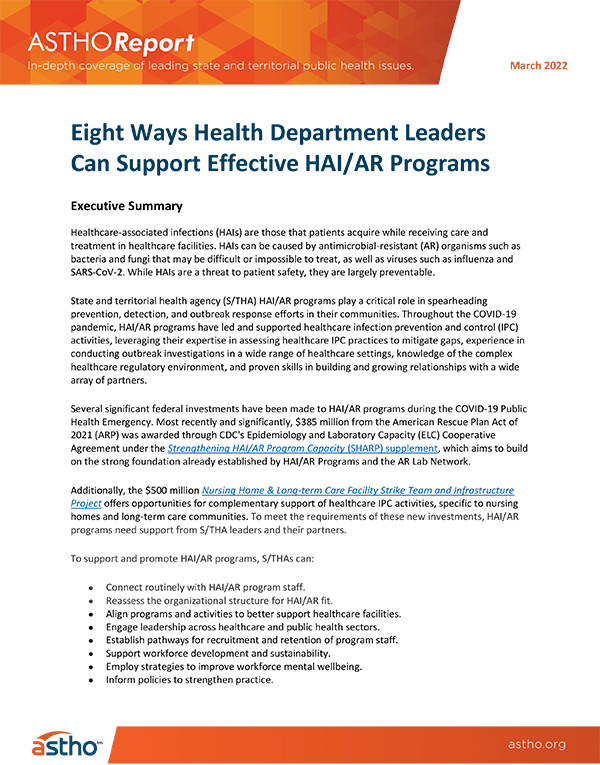Eight Ways Health Department Leaders Can Support Effective HAI/AR Programs
March 28, 2022
 Healthcare-associated infections (HAIs) are those that patients acquire while receiving care and treatment in healthcare facilities. HAIs can be caused by antimicrobial-resistant (AR) organisms such as bacteria and fungi that may be difficult or impossible to treat, as well as viruses such as influenza and SARS-CoV-2. While HAIs are a threat to patient safety, they are largely preventable.
Healthcare-associated infections (HAIs) are those that patients acquire while receiving care and treatment in healthcare facilities. HAIs can be caused by antimicrobial-resistant (AR) organisms such as bacteria and fungi that may be difficult or impossible to treat, as well as viruses such as influenza and SARS-CoV-2. While HAIs are a threat to patient safety, they are largely preventable.
State and territorial health agency (S/THA) HAI/AR programs play a critical role for spearheading prevention, detection, and outbreak response efforts in their communities. Throughout the COVID-19 pandemic, HAI/AR programs have led and supported healthcare infection prevention and control (IPC) activities, leveraging their expertise in assessing healthcare IPC practices to mitigate gaps, experience in conducting outbreak investigations in a wide range of healthcare settings, knowledge of the complex healthcare regulatory environment, and proven skills in building and growing relationships with a wide array of partners.
Several significant federal investments have been made to HAI/AR programs during the COVID-19 Public Health Emergency. Most recently and significantly, $385 million from the American Rescue Plan Act of 2021 (ARP) was awarded through CDC's Epidemiology and Laboratory Capacity (ELC) Cooperative Agreement under the Strengthening HAI/AR Program Capacity (SHARP) supplement, which aims to build on the strong foundation already established by HAI/AR Programs and the AR Lab Network.
Additionally, the $500 million Nursing Home & Long-Term Care Facility Strike Team and Infrastructure Project offers opportunities for complementary support of healthcare IPC activities, specific to nursing homes and long-term care communities. To meet the requirements of these new investments, HAI/AR programs need support from S/THA leaders and their partners.
To best support HAI/AR programs, S/THAs can consider the following:
- Connect routinely with program staff.
- Reassess the organizational structure for HAI/AR fit.
- Align programs and activities.
- Engage leadership across healthcare and public health sectors.
- Establish pathways for recruitment and retention.
- Support workforce development and sustainability.
- Employ strategies to improve workforce mental wellbeing.
- Inform policies to strengthen practice.